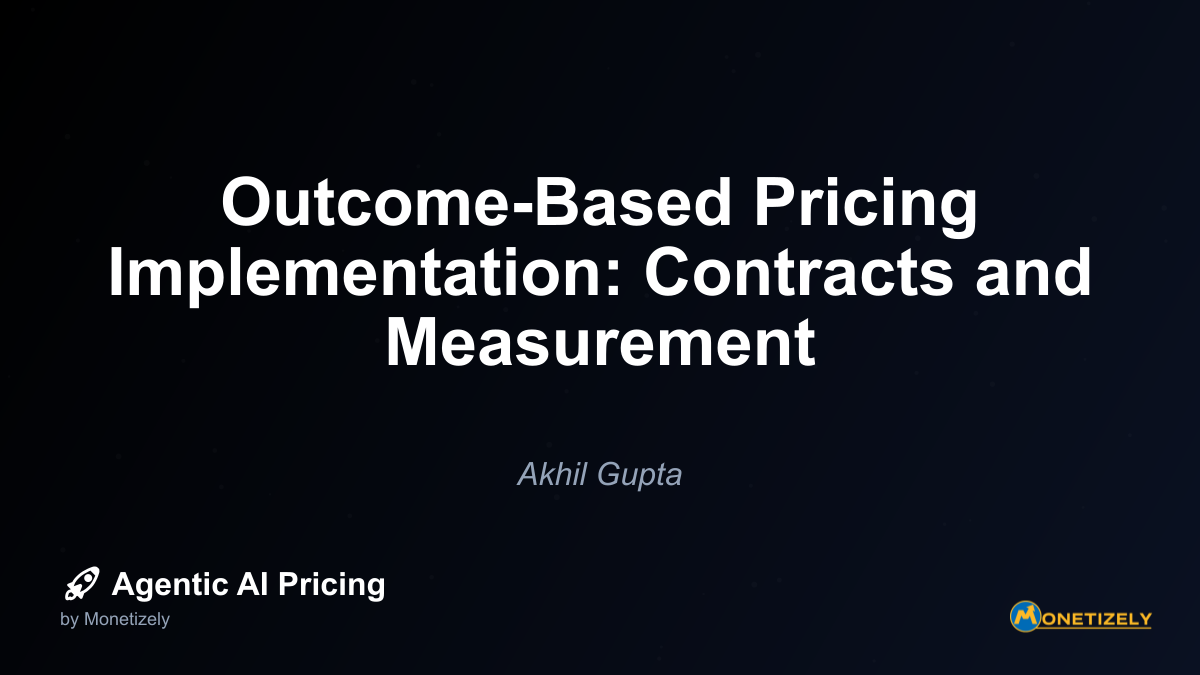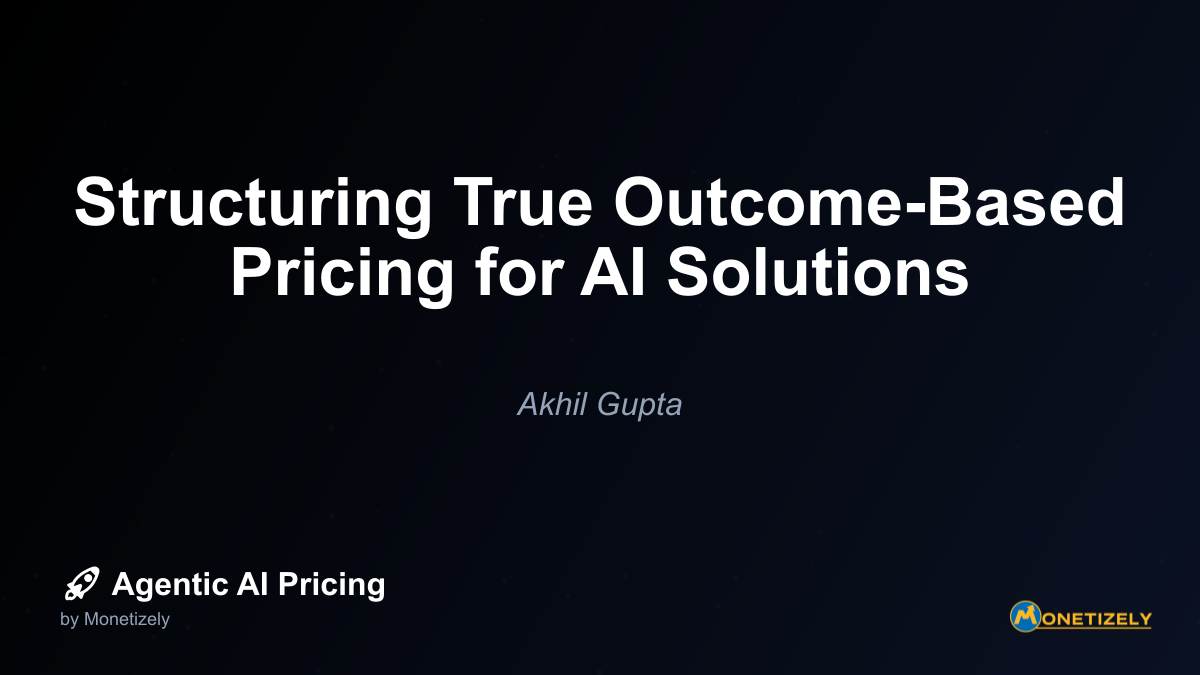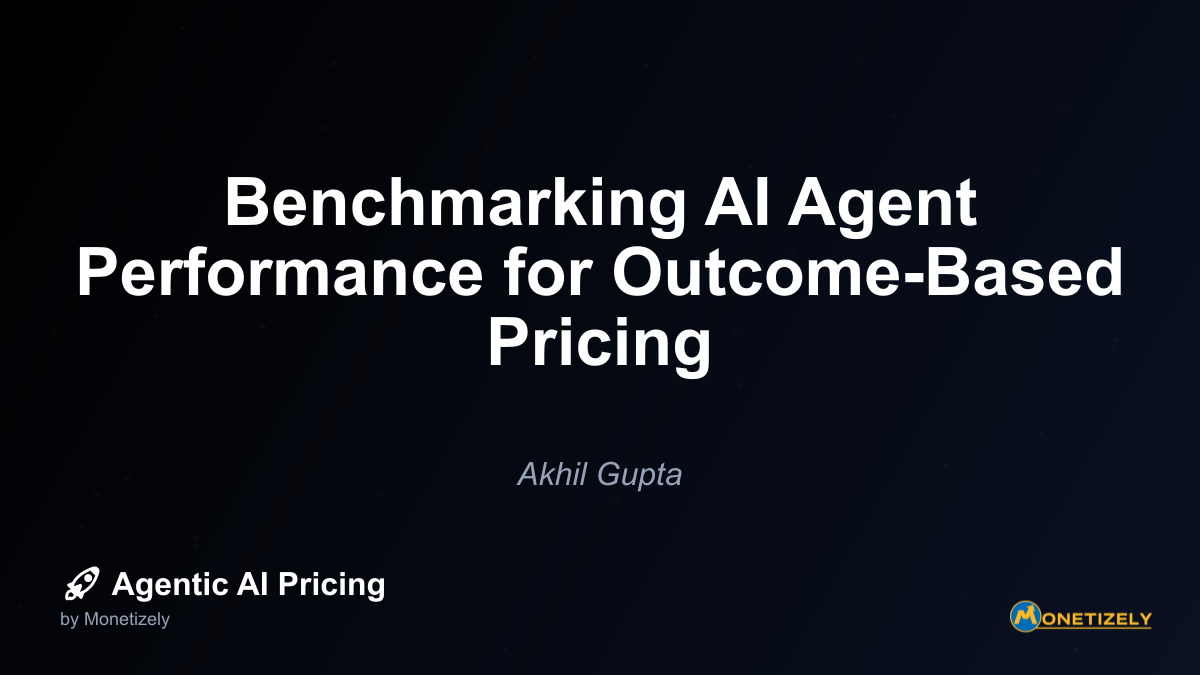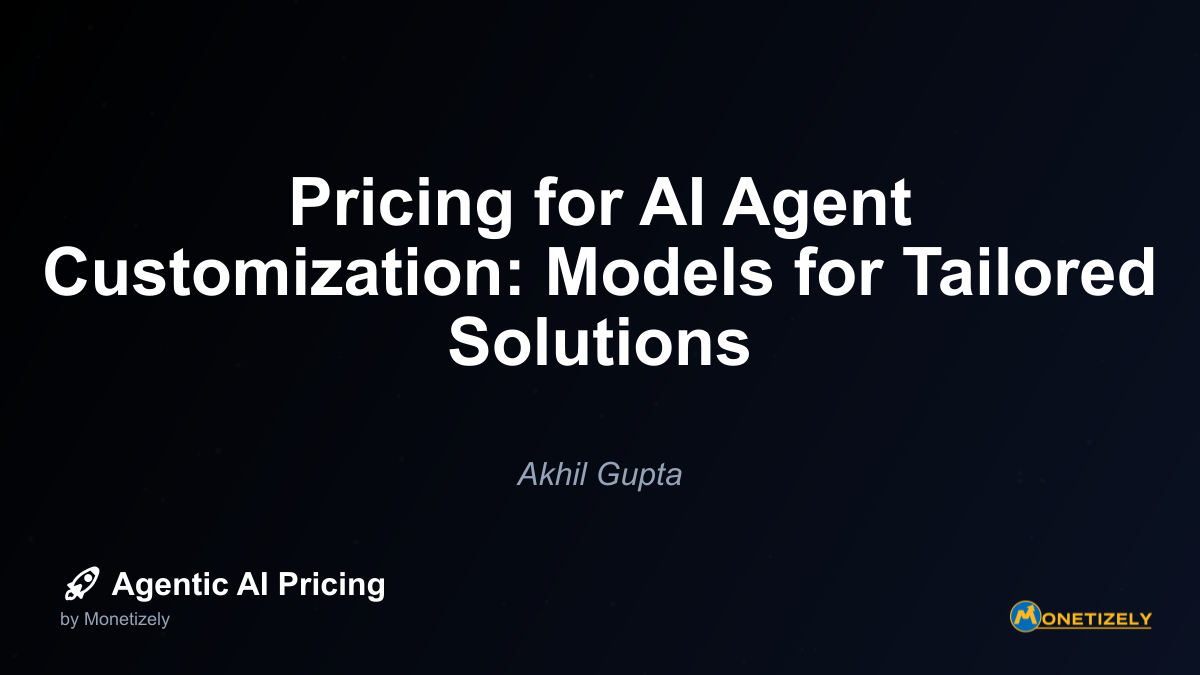· Akhil Gupta · Implementation · 12 min read
Outcome-Based Pricing Implementation: Contracts and Measurement
AI and SaaS Pricing Masterclass
Learn the art of strategic pricing directly from industry experts. Our comprehensive course provides frameworks and methodologies for optimizing your pricing strategy in the evolving AI landscape. Earn a professional certification that can be imported directly to your LinkedIn profile.

In today’s dynamic business landscape, organizations deploying agentic AI solutions are increasingly shifting toward outcome-based pricing models that align costs directly with measurable business results. This strategic approach requires carefully structured contracts and robust measurement frameworks to ensure both vendors and clients benefit from the arrangement. This comprehensive guide explores the intricacies of implementing outcome-based pricing for AI services, with a focus on contract structuring and performance measurement.
Understanding Outcome-Based Pricing for AI Services
Outcome-based pricing fundamentally restructures how AI services are monetized, moving away from traditional input-based models (like time, resources, or usage) toward compensation based on specific, measurable business outcomes. This approach aligns vendor incentives directly with client success, creating a shared-risk, shared-reward partnership.
Under this model, clients pay only when the AI solution delivers predefined results that directly contribute to business value. These outcomes might include cost savings, revenue growth, efficiency improvements, error reduction, or other quantifiable benefits that demonstrate tangible return on investment.
According to recent market research, organizations implementing outcome-based AI pricing models report 27% higher satisfaction with vendors and 31% better ROI compared to traditional pricing approaches. This trend is accelerating as AI capabilities mature and organizations seek more accountable, value-driven technology partnerships.
The Strategic Framework for Contract Development
Successful outcome-based pricing implementation hinges on meticulously structured contracts that clearly define success metrics, measurement methodologies, and verification procedures. These contracts serve as the foundation for the entire relationship, establishing transparency and trust between parties.
Core Contract Components
Clear Definition of Outcomes: Contracts must precisely define what constitutes success, using specific, measurable events such as revenue growth, cost savings, error reduction, or successful resolution of customer inquiries.
Baseline Commitments: Many contracts include minimum guaranteed outcomes or free baseline services to reduce client risk and ensure essential service levels.
Pricing Structure: Fees are directly tied to successful outcomes, often calculated per event (e.g., per qualified lead, resolved issue, or cost saving percentage).
Transparency and Monitoring: Detailed provisions for performance tracking, including tools, dashboards, and reporting requirements that provide visibility into AI system performance.
Caps and Floors: Maximum and minimum payment thresholds to manage cost predictability and risk for both parties.
Risk Allocation: Clear delineation of responsibilities and risk-sharing arrangements, including performance guarantees and remediation procedures.
Data Governance: Provisions addressing data ownership, privacy, security, and usage rights, particularly important given the extensive data collection required for outcome measurement.
Term and Termination: Contract duration, renewal conditions, and termination rights, often with specific performance-based exit clauses.
Risk Allocation Strategies
Effective outcome-based contracts must thoughtfully distribute risk between vendors and clients. According to BCG research, successful implementations typically employ hybrid pricing models that blend fixed and variable components:
- Minimum Fee Commitments: Baseline payments that ensure vendors recover some costs regardless of outcome achievement
- Success Fee Structures: Variable payments tied directly to measured outcomes, often calculated as a percentage of realized value
- Performance Bonds: Funds held in escrow and released upon achievement of specific milestones
- Graduated Pricing Tiers: Increasing or decreasing rates based on performance levels
- Gain-Share Arrangements: Splitting the financial benefits of outcomes between vendor and client
A Deloitte study found that 78% of successful outcome-based pricing arrangements include some form of fixed component to balance risk, particularly during initial implementation phases when outcomes may be more difficult to achieve.
Defining and Selecting Success Metrics
The foundation of any outcome-based pricing contract lies in carefully defined metrics that accurately capture the value delivered by the AI system. These metrics must be relevant, measurable, attributable to the AI solution, and aligned with strategic business objectives.
Criteria for Effective Metrics Selection
Direct Business Impact: Metrics should directly correlate with tangible business value rather than technical performance indicators.
Measurability: Outcomes must be objectively quantifiable using available data and measurement tools.
Attribution: The impact of the AI solution must be distinguishable from other factors influencing the outcome.
Alignment: Metrics should support strategic business goals and incentivize desired behaviors from both parties.
Simplicity: While comprehensive, metrics should remain understandable and manageable to avoid excessive complexity in measurement and verification.
According to research from Monetizely, the most successful outcome-based AI pricing implementations limit their focus to 3-5 core metrics that directly reflect business value, rather than attempting to measure every possible benefit.
Industry-Specific Metrics Examples
Different industries require tailored metrics that reflect their unique business contexts and value drivers:
Healthcare
- Reduction in hospital readmission rates
- Improvement in diagnostic accuracy
- Treatment adherence rates
- Cost savings from preventive interventions
- Patient outcome improvements
Contract Structure: Milestone payments based on clinical endpoints or quantified health outcomes
Verification Methods: Independent clinical audits, patient records analysis, claims data analytics
Challenges: Complex regulatory environment, sensitivity of health data, difficulty in outcome attribution due to multiple factors
Best Practices: Define clear clinical endpoints, include third-party validation, pilot with well-defined patient populations
Financial Services
- Fraud detection and prevention rates
- Reduction in false positives
- Portfolio return improvements
- Compliance adherence rates
- Transaction processing accuracy
Contract Structure: Shared savings models, performance bonuses for fraud detection improvements
Verification Methods: Transaction log audits, financial performance reports, regulatory compliance checks
Challenges: Highly regulated environment, need for transparency, market volatility influences
Best Practices: Use standardized metrics, involve compliance teams early, establish realistic baselines
Manufacturing
- Production efficiency improvements
- Defect reduction rates
- Predictive maintenance impact (downtime reduction)
- Energy consumption optimization
- Supply chain optimization metrics
Contract Structure: Agreements tied to productivity improvements or cost savings percentages
Verification Methods: Machine data logs, quality control reports, maintenance records
Challenges: Integration with legacy systems, isolating AI impact from other process changes
Best Practices: Start with pilot production lines, invest in sensor infrastructure, establish clear baselines
Customer Service
- First-contact resolution rates
- Average handling time reduction
- Customer satisfaction score improvements
- Self-service adoption rates
- Issue escalation reduction
Contract Structure: Pricing based on resolved cases or satisfaction score improvements, often combined with usage fees
Verification Methods: Call recording analysis, satisfaction surveys, support ticket data analysis
Challenges: Varying case complexity, subjective customer feedback, handling escalations
Best Practices: Combine outcome and consumption pricing, clearly define resolution criteria
Measurement Frameworks and Verification Methods
The credibility of outcome-based pricing depends on robust measurement frameworks that accurately capture and verify results. These frameworks must balance comprehensiveness with practicality, ensuring reliable data without creating excessive administrative burden.
Measurement Infrastructure Requirements
Implementing outcome-based pricing requires sophisticated technical infrastructure:
Data Collection Systems: Integration with customer systems, IoT sensors, cloud analytics, and CRM platforms to capture performance data
Real-Time Analytics: AI-powered dashboards and reporting tools that provide continuous visibility into performance metrics
Secure Data Pipelines: Ensuring data integrity and security throughout the measurement process
Integration Capabilities: Connecting with existing business systems to correlate AI performance with business outcomes
Audit Trails: Immutable records of system performance and outcome achievement for verification purposes
According to recent implementation studies, organizations typically invest 15-20% of their total AI project budget in measurement infrastructure to support outcome-based pricing models.
Verification Methodologies
Verification approaches vary based on industry, outcome complexity, and relationship maturity:
Automated Verification: AI-powered systems that continuously monitor performance against predefined metrics, often with built-in anomaly detection
Joint Review Processes: Regular collaborative sessions between vendor and client to review performance data and address any discrepancies
Third-Party Audits: Independent verification of outcomes by neutral third parties, particularly valuable for high-value or contentious arrangements
Data Validation Protocols: Standardized procedures for ensuring data quality and integrity in measurement
Blockchain-Based Verification: Emerging approaches using distributed ledger technology to create immutable, transparent records of performance
A McKinsey study found that 67% of successful outcome-based pricing implementations include some form of independent verification to build trust and credibility in reported results.
Audit Processes and Dispute Resolution
Even with robust measurement frameworks, disputes may arise regarding outcome attribution or measurement accuracy. Effective contracts include clear processes for resolving these issues:
Predefined Escalation Paths: Step-by-step procedures for addressing measurement disagreements
Governance Councils: Joint committees with representatives from both parties authorized to resolve disputes
Independent Arbitration: Third-party mediation for unresolved conflicts, often with specific industry expertise
Data Reconciliation Procedures: Technical processes for identifying and addressing data discrepancies
Contract Adjustment Mechanisms: Provisions for modifying metrics or measurement approaches based on experience
According to legal experts specializing in AI contracts, the most successful dispute resolution frameworks emphasize collaborative problem-solving rather than punitive measures, recognizing that outcome measurement is inherently complex and often requires refinement over time.
Implementation Challenges and Solutions
Despite its strategic benefits, implementing outcome-based pricing for AI services presents significant challenges that must be proactively addressed.
Data Privacy and Security Considerations
Outcome measurement requires extensive data collection, raising important privacy concerns:
Challenges:
- Compliance with data protection regulations (GDPR, CCPA, etc.)
- Handling of sensitive personal or business information
- Potential exposure of proprietary business processes
Solutions:
- Implement strong data governance frameworks
- Use anonymization or pseudonymization techniques
- Establish clear data usage agreements
- Obtain proper consent from data subjects
- Embed privacy-by-design principles in measurement systems
Technical Implementation Challenges
The technical complexity of outcome measurement presents several obstacles:
Challenges:
- Integration with existing systems and data sources
- Ensuring data quality and consistency
- Building reliable attribution models
- Handling edge cases and anomalies
- Maintaining system performance at scale
Solutions:
- Conduct thorough technical due diligence before implementation
- Develop comprehensive integration strategies
- Implement data validation and cleaning procedures
- Use advanced analytics for attribution modeling
- Build scalable, cloud-based measurement infrastructure
Organizational Change Management
Transitioning to outcome-based pricing requires significant organizational adaptation:
Challenges:
- Shifting mindsets from input-based to outcome-based thinking
- Aligning incentives across departments
- Managing revenue uncertainty
- Building new skills and capabilities
- Overcoming resistance to change
Solutions:
- Conduct stakeholder workshops to build understanding and buy-in
- Implement pilot programs before full-scale adoption
- Develop clear communication strategies
- Provide training and support for affected teams
- Create cross-functional collaboration structures
A recent survey by Forrester found that 65% of organizations cited change management as their biggest challenge in implementing outcome-based pricing, highlighting the importance of addressing both technical and human factors.
Case Studies: Successful Implementations
Examining real-world implementations provides valuable insights into effective practices and potential pitfalls.
Case Study 1: AI-Powered Sales Development
Company: Enterprise SaaS provider
Challenge: Traditional lead generation pricing didn’t align with actual business impact
Solution: Shifted from charging per lead to paying per qualified opportunity
Implementation:
- Developed clear definition of “qualified opportunity” with specific criteria
- Implemented joint CRM integration for transparent tracking
- Established baseline conversion rates before implementation
- Created graduated pricing tiers based on opportunity quality
- Included minimum monthly commitment to reduce vendor risk
Results:
- 42% increase in sales pipeline quality
- 28% reduction in cost per qualified opportunity
- Improved alignment between marketing and sales teams
- Higher vendor accountability and performance
Case Study 2: AI Customer Service Automation
Company: Global telecommunications provider
Challenge: Traditional pricing based on conversation volume didn’t incentivize resolution quality
Solution: Implemented outcome-based pricing tied to successful issue resolution
Implementation:
- Defined “successful resolution” as issues resolved without human escalation
- Developed AI-powered verification system to classify resolution success
- Implemented customer satisfaction measurement as secondary metric
- Created hybrid pricing model with base fee plus outcome-based components
- Established regular review process to refine resolution definitions
Results:
- 35% improvement in first-contact resolution rate
- 22% increase in customer satisfaction scores
- Reduced total customer service costs by 18%
- More strategic partnership between vendor and client
Case Study 3: AI-Powered Manufacturing Optimization
Company: Automotive components manufacturer
Challenge: Difficulty justifying AI investment based on traditional ROI models
Solution: Outcome-based pricing tied to defect reduction and efficiency improvements
Implementation:
- Installed comprehensive sensor network for continuous measurement
- Established six-month baseline period before implementation
- Created gain-sharing model based on documented cost savings
- Implemented independent verification by manufacturing engineers
- Developed phased implementation plan with increasing outcome targets
Results:
- 27% reduction in defect rates
- 15% improvement in production efficiency
- Clear attribution of value to AI implementation
- Accelerated adoption across additional production lines
Handling Edge Cases and Contract Evolution
Outcome-based pricing contracts must anticipate and address various scenarios that may arise during implementation, particularly as AI capabilities evolve over time.
Managing Edge Cases
Effective contracts include provisions for handling unusual or unexpected situations:
Force Majeure Clauses: Addressing external factors beyond either party’s control that may affect outcomes
Market Condition Adjustments: Mechanisms for modifying metrics or targets based on significant market changes
Technology Evolution Provisions: Procedures for incorporating new AI capabilities or measurement approaches
Scope Change Management: Processes for handling changes in business requirements or objectives
Performance Variance Handling: Approaches for addressing unexpected performance fluctuations, both positive and negative
Contract Revision Strategies
As relationships mature and AI capabilities evolve, contracts should adapt accordingly:
Scheduled Review Points: Predetermined times for reassessing metrics and measurement approaches
Performance-Based Adjustments: Automatic modifications based on sustained performance levels
Technology Refresh Provisions: Mechanisms for incorporating new AI capabilities or measurement techniques
Value Recalibration Processes: Methods for reassessing the financial value of outcomes as business conditions change
Relationship Evolution Framework: Pathways for transitioning from initial implementation to mature partnership
According to contract management experts, the most successful outcome-based pricing arrangements include semi-annual review processes that evaluate both technical performance and business alignment, with formal revision opportunities at least annually.
Legal and Compliance Considerations
Outcome-based pricing contracts must address various legal and regulatory requirements to ensure enforceability and compliance.
Contract Structuring Legal Considerations
Key legal elements to address include:
Clear Definition of Terms: Precise legal definitions of outcomes, measurements, and responsibilities
Intellectual Property Rights: Ownership of AI models, data, and improvements resulting from the implementation
Liability Limitations: Appropriate caps on damages and exclusions for indirect or consequential losses
Confidentiality Provisions: Protection of sensitive business information exposed during measurement
Regulatory Compliance: Adherence to industry-specific regulations and data protection laws
Regulatory Compliance
Industry-specific regulations may impact outcome-based pricing implementation:
Healthcare: HIPAA, FDA requirements for medical AI applications
Financial Services: Banking regulations, anti-money laundering compliance, securities laws
Public Sector: Procurement regulations, transparency requirements
Consumer Protection: Truth in advertising, consumer data protection laws
International Considerations: Cross-border data transfer restrictions, local regulatory requirements
Legal experts recommend involving compliance teams early in contract development, particularly for regulated industries where specific requirements may impact measurement approaches or data handling practices.
Future Trends in Outcome-Based AI Pricing
The landscape of outcome-based pricing for AI services continues to evolve rapidly, with several important trends emerging:
Evolving Measurement Technologies
Advances in measurement and verification are enhancing the feasibility and reliability of outcome-based pricing:
Explainable AI: Improved attribution capabilities that clearly demonstrate causality between AI actions and outcomes
Blockchain-Based Verification: Immutable, transparent records of performance and outcomes
Advanced Attribution Models: Sophisticated approaches for isolating AI impact from other factors
Real-Time Measurement: Continuous monitoring and instant verification of outcomes
Federated Learning: Privacy-preserving measurement approaches that protect sensitive data
Hybrid Pricing Models
The market is increasingly moving toward sophisticated hybrid models that combine multiple pricing approaches:
Outcome-Usage Hybrids: Blending outcome-based components with traditional usage metrics
Tiered Outcome Pricing: Different pricing levels based on outcome quality or magnitude
Portfolio Approaches: Diversified pricing across different AI capabilities within a single solution
Risk-Adjusted Models: Pricing structures that adapt based on outcome predictability
Value-Based Subscriptions: Subscription models with outcome-based components or guarantees
According to industry analysts, by 2026, more than 60% of enterprise AI implementations are expected to include some form of outcome-based pricing component, though pure outcome-based models will remain less common than hybrid approaches.
Regulatory Evolution
The regulatory landscape for AI pricing is also evolving:
Increased Transparency Requirements: Regulations mandating clearer disclosure of pricing methodologies
AI-Specific Regulations: New legal frameworks addressing AI accountability and performance
Industry Standards:
Co-Founder & COO
Akhil is an Engineering leader with over 16+ years of experience in building, managing and scaling web-scale, high throughput enterprise applications and teams. He has worked with and led technology teams at FabAlley, BuildSupply and Healthians. He is a graduate from Delhi College of Engineering and UC Berkeley certified CTO.
Pricing Strategy Audit
Let our experts analyze your current pricing strategy and identify opportunities for improvement. Our data-driven assessment will help you unlock untapped revenue potential and optimize your AI pricing approach.




